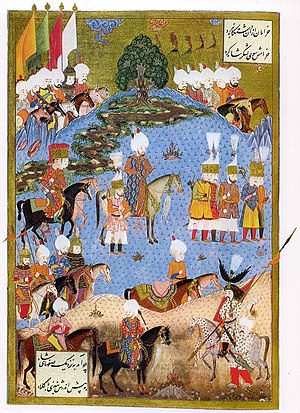Ottoman-Safavid War (1532–1555)

Persian miniature painting : Suleyman invades Nakhichevan with his army at the end of the Ottoman-Safavid War .
| date | 1532 to 1555 |
|---|---|
| place | Iraq , Armenia , Iran |
| output | Ottoman victory |
| consequences | Baghdad, Mesopotamia, the mouths of the Euphrates and Tigris and part of the coast of the Persian Gulf go to the Ottomans |
| Peace treaty | Peace from Amasya |
| Parties to the conflict | |
|---|---|
| Commander | |
|
Suleyman I. |
|
| Troop strength | |
| unknown | unknown |
| losses | |
|
unknown |
unknown |
The Ottoman-Safavid War from 1532 to 1555 was a military conflict between the Ottoman Empire under Suleyman I and the Persian Safavid Empire under Tahmasp I.
background
The war was triggered by territorial clashes between the two empires, especially when the Bey (prince) Shams ud-Dīn of Bitlis placed himself under Persian protection. There was also an attack by the Persian side on the governor of Baghdad , a sympathizer of Suleyman.
Persia also negotiated with the House of Habsburg to form an alliance that would attack the Ottoman Empire on two fronts, but that never came about.
Course of war
First campaign (1532-1534)
The Ottomans, first under the Grand Vizier Makbul Ibrahim Pasha and later supported by Sultan Suleyman, had successfully attacked the Safavids in Iraq , took Bitlis again and occupied Tabriz and then Baghdad in 1534. During the withdrawal of his troops, Tahmasp pursued a scorched earth tactic .
Second Campaign (1548-1549)
Suleyman launched a second campaign from 1548 to 1549 to finally defeat the Shah . Tahmasp, in turn, pursued scorched earth and devastated Armenia tactics . In 1536, the French King Francis I and Suleyman had formed a Franco-Ottoman alliance that offset the threat from the Habsburgs. When Suleyman attacked Persia in 1547, France sent its ambassador Gabriel de Luetz to support him in his campaign. Gabriel de Luetz was able to give Süleyman crucial military advice. Suleyman had successes in Tabriz, in the Iranian part of Armenia and took some fortresses in Georgia .
Third Campaign (1553–1555)
In 1553, Suleyman began his third and final campaign against Tahmasp. After initial failures, he was able to regain Erzurum . Territorial gains for the Ottomans were secured by the Peace of Amasya in 1555. Suleyman returned to Tabriz, but kept Baghdad, Mesopotamia , the mouths of the Euphrates and Tigris, and part of the coast of the Persian Gulf .
Because of his obligations in Persia, Suleyman was barely able to send fleets to aid the Franco-Ottoman invasion of Corsica.
literature
Walter Posch : Ottoman-Safavid Relations 1545–1550: The Fall of Alḳâs Mîrzâ. VÖAW, Vienna 2013, ISBN 978-3-7001-7308-3 .
Individual evidence
- ^ A b c Peter Malcolm Holt, Ann KS Lambton, Bernard Lewis: The Cambridge history of Islam , p. 330
- ^ A b William Bayne Fisher: The Cambridge history of Iran , pp. 384ff